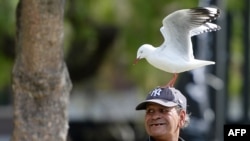Ninety percent of all seabirds have eaten plastic and nearly every one will have by 2050, according to a new study.
The report Monday in the Proceedings of the National Academy of Sciences said less than five percent of seabirds were carrying plastic in their bodies in the early 1960s, just after a boom in industrial plastic manufacturing.
The researchers say they found all sorts of plastic items inside seabirds, including balloons, glowsticks, cigarette lighters, model cars and toys.
They said albatross, penguins, shearwaters and seagulls are most likely to eat plastic, which can cause severe illness or death.
The birds mistake the plastic pollution for fish eggs or other legitimate food.
The study says while plastic ingestion has fallen around U.S. and European waters because of a reduction in the use of plastic pellets, it is especially bad in the Pacific near Australia and New Zealand where a large number of bird species live.






